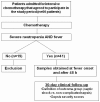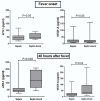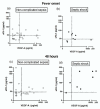Time-course of sFlt-1 and VEGF-A release in neutropenic patients with sepsis and septic shock: a prospective study
- PMID: 21371321
- PMCID: PMC3058017
- DOI: 10.1186/1479-5876-9-23
Time-course of sFlt-1 and VEGF-A release in neutropenic patients with sepsis and septic shock: a prospective study
Abstract
Background: Septic shock is the most feared complication of chemotherapy-induced febrile neutropenia. So far, there are no robust biomarkers that can stratify patients to the risk of sepsis complications. The VEGF-A axis is involved in the control of microvascular permeability and has been involved in the pathogenesis of conditions associated with endothelial barrier disruption such as sepsis. sFlt-1 is a soluble variant of the VEGF-A receptor VEGFR-1 that acts as a decoy receptor down-regulating the effects of VEGF-A. In animal models of sepsis, sFlt-1 was capable to block the barrier-breaking negative effects of VEGF-A and to significantly decrease mortality. In non-neutropenic patients, sFlt-1 has been shown to be a promising biomarker for sepsis severity.
Methods: We prospectively evaluated concentrations of sFlt-1 and VEGF-A at different time-points during febrile neutropenia, and evaluated the association of these levels with sepsis severity and septic shock development.
Results: Neutropenic patients that evolved with septic shock (n = 10) presented higher levels of sFlt-1 and VEGF-A measured 48 hours after fever onset than patients with non-complicated sepsis (n = 31) and levels of these biomarkers correlated with sepsis severity scores. Estimation of the diagnostic accuracy of sFlt-1 levels for the discrimination of patients that evolved to septic shock yielded promising results in our study population.
Discussion: Our data suggest that sFlt-1 and VEGF-A could be useful biomarkers for sepsis severity in patients with febrile neutropenia. In addition, the kinetics of sFlt-1 release in patients that evolve to septic shock suggest that the sFlt-1 could be a salvage compensatory mechanism in patients with septic shock, but that the magnitude of the sFlt-1 release observed in human sepsis is not sufficient to reproduce the beneficial anti-VEGF-A effects observed in animal models of sepsis.
Figures



Similar articles
-
A high angiopoietin-2/angiopoietin-1 ratio is associated with a high risk of septic shock in patients with febrile neutropenia.Crit Care. 2013 Aug 5;17(4):R169. doi: 10.1186/cc12848. Crit Care. 2013. PMID: 23915833 Free PMC article.
-
Vascular Endothelial Growth Factor and Soluble Vascular Endothelial Growth Factor Receptor as Novel Biomarkers for Poor Outcomes in Children With Severe Sepsis and Septic Shock.Pediatr Emerg Care. 2020 Dec;36(12):e715-e719. doi: 10.1097/PEC.0000000000001638. Pediatr Emerg Care. 2020. PMID: 30335688
-
Imbalances in serum angiopoietin concentrations are early predictors of septic shock development in patients with post chemotherapy febrile neutropenia.BMC Infect Dis. 2010 May 28;10:143. doi: 10.1186/1471-2334-10-143. BMC Infect Dis. 2010. PMID: 20509945 Free PMC article.
-
Value of the biomarker soluble tyrosine kinase 1 type fms (sFLT-1) in the diagnosis and prognosis of sepsis: a systematic review.Med Clin (Barc). 2024 Sep 13;163(5):224-231. doi: 10.1016/j.medcli.2024.03.027. Epub 2024 Jun 8. Med Clin (Barc). 2024. PMID: 38851948 English, Spanish.
-
Nursing Care of Oncology Patients with Sepsis.Semin Oncol Nurs. 2021 Apr;37(2):151130. doi: 10.1016/j.soncn.2021.151130. Epub 2021 Mar 13. Semin Oncol Nurs. 2021. PMID: 33722431 Review.
Cited by
-
Using angiogenic factors and their soluble receptors to predict organ dysfunction in patients with disseminated intravascular coagulation associated with severe trauma.Crit Care. 2012 Dec 12;16(2):R63. doi: 10.1186/cc11309. Crit Care. 2012. PMID: 22520052 Free PMC article.
-
Association of the immature platelet fraction with sepsis diagnosis and severity.Sci Rep. 2015 Jan 26;5:8019. doi: 10.1038/srep08019. Sci Rep. 2015. PMID: 25620275 Free PMC article.
-
Prognostic role of elevated VEGF in sepsis: A systematic review and meta-analysis.Front Physiol. 2022 Jul 22;13:941257. doi: 10.3389/fphys.2022.941257. eCollection 2022. Front Physiol. 2022. PMID: 35936894 Free PMC article.
-
Identification of Potential Early Diagnostic Biomarkers of Sepsis.J Inflamm Res. 2021 Mar 3;14:621-631. doi: 10.2147/JIR.S298604. eCollection 2021. J Inflamm Res. 2021. PMID: 33688234 Free PMC article.
-
Association of Ang/Tie2 pathway mediators with endothelial barrier integrity and disease severity in COVID-19.Front Physiol. 2023 Feb 21;14:1113968. doi: 10.3389/fphys.2023.1113968. eCollection 2023. Front Physiol. 2023. PMID: 36895630 Free PMC article.
References
Publication types
MeSH terms
Substances
LinkOut - more resources
Full Text Sources
Other Literature Sources

